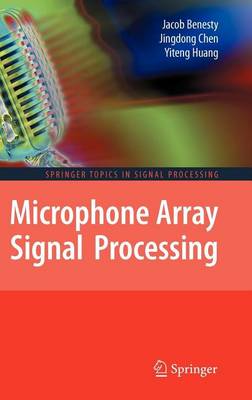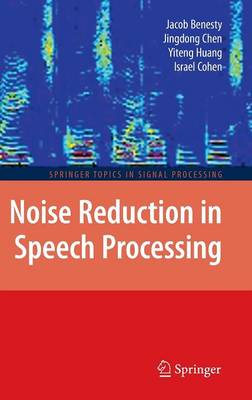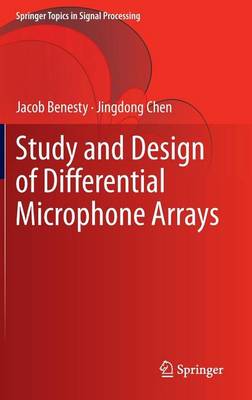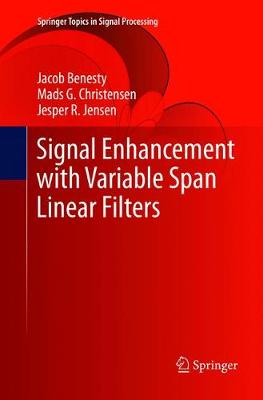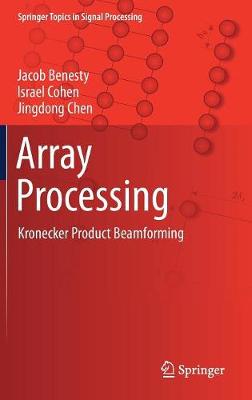Springer Topics in Signal Processing
7 primary works
Book 1
Microphone Array Signal Processing
by Jacob Benesty, Jingdong Chen, and Yiteng Huang
Book 2
Noise Reduction in Speech Processing
by Jacob Benesty, Jingdong Chen, Yiteng Huang, and Israel Cohen
Noise is everywhere and in most applications that are related to audio and speech, such as human-machine interfaces, hands-free communications, voice over IP (VoIP), hearing aids, teleconferencing/telepresence/telecollaboration systems, and so many others, the signal of interest (usually speech) that is picked up by a microphone is generally contaminated by noise. As a result, the microphone signal has to be cleaned up with digital signal processing tools before it is stored, analyzed, transmitted, or played out. This cleaning process is often called noise reduction and this topic has attracted a considerable amount of research and engineering attention for several decades. One of the objectives of this book is to present in a common framework an overview of the state of the art of noise reduction algorithms in the single-channel (one microphone) case. The focus is on the most useful approaches, i.e., filtering techniques (in different domains) and spectral enhancement methods. The other objective of Noise Reduction in Speech Processing is to derive all these well-known techniques in a rigorous way and prove many fundamental and intuitive results often taken for granted. This book is especially written for graduate students and research engineers who work on noise reduction for speech and audio applications and want to understand the subtle mechanisms behind each approach. Many new and interesting concepts are presented in this text that we hope the readers will find useful and inspiring.
Book 4
A Perspective on Stereophonic Acoustic Echo Cancellation
by Jacob Benesty, Constantin Paleologu, Tomas Gansler, and Silviu Ciochina
Book 6
Study and Design of Differential Microphone Arrays
by Jacob Benesty and Jingdong Chen
Microphone arrays have attracted a lot of interest over the last few decades since they have the potential to solve many important problems such as noise reduction/speech enhancement, source separation, dereverberation, spatial sound recording, and source localization/tracking, to name a few. However, the design and implementation of microphone arrays with beamforming algorithms is not a trivial task when it comes to processing broadband signals such as speech. Indeed, in most sensor arrangements, the beamformer output tends to have a frequency-dependent response. One exception, perhaps, is the family of differential microphone arrays (DMAs) who have the promise to form frequency-independent responses. Moreover, they have the potential to attain high directional gains with small and compact apertures. As a result, this type of microphone arrays has drawn much research and development attention recently. This book is intended to provide a systematic study of DMAs from a signal processing perspective. The primary objective is to develop a rigorous but yet simple theory
for the design, implementation, and performance analysis of DMAs. The theory includes some signal processing techniques for the design of commonly used first-order, second-order, third-order, and also the general Nth-order DMAs. For each order, particular examples are given on how to form standard directional patterns such as the dipole, cardioid, supercardioid, hypercardioid, subcardioid, and quadrupole. The study demonstrates the performance of the different order DMAs in terms of beampattern, directivity factor, white noise gain, and gain for point sources. The inherent relationship between differential processing and adaptive beamforming is discussed, which provides a better understanding of DMAs and why they can achieve high directional gain. Finally, we show how to design DMAs that can be robust against white noise amplification.
Book 7
Signal Enhancement with Variable Span Linear Filters
by Jacob Benesty, Mads G. Christensen, and Jesper R. Jensen
Book 12
Design of Circular Differential Microphone Arrays
by Jacob Benesty, Jingdong Chen, and Israel Cohen
Recently, we proposed a completely novel and efficient way to design differential beamforming algorithms for linear microphone arrays. Thanks to this very flexible approach, any order of differential arrays can be designed. Moreover, they can be made robust against white noise amplification, which is the main inconvenience in these types of arrays. The other well-known problem with linear arrays is that electronic steering is not really feasible.
In this book, we extend all these fundamental ideas to circular microphone arrays and show that we can design small and compact differential arrays of any order that can be electronically steered in many different directions and offer a good degree of control of the white noise amplification problem, high directional gain, and frequency-independent response. We also present a number of practical examples, demonstrating that differential beamforming with circular microphone arrays is likely one of the best candidates for applications involving speech enhancement (i.e., noise reduction and dereverberation). Nearly all of the material presented is new and will be of great interest to engineers, students, and researchers working with microphone arrays and their applications in all types of telecommunications, security and surveillance contexts.
Book 18
The focus of this book is on array processing and beamforming with Kronecker products. It considers a large family of sensor arrays that allow the steering vector to be decomposed as a Kronecker product of two steering vectors of smaller virtual arrays. Instead of directly designing a global beamformer for the original array, once the steering vector has been decomposed, smaller virtual beamformers are designed and separately optimized for each virtual array. This means the matrices that need to be inverted are smaller, which increases the robustness of the beamformers, and reduces the size of the observations.
The book explains how to perform beamforming with Kronecker product filters using an unconventional approach. It shows how the Kronecker product formulation can be used to derive fixed, adaptive, and differential beamformers with remarkable flexibility. Furthermore, it demonstrates how fixed and adaptive beamformers can be intelligently combined, optimally exploiting the advantages of both. The problem of spatiotemporal signal enhancement is also addressed, and readers will learn how to perform Kronecker product filtering in this context.